In a real life survival situation, knowing how to live off the land may be crucial for you and your family. Along with shelter, fire and water, food is one of those things we’re all dependent upon, hence the fine art of hunting has been practiced by humans since time immemorial.
All ancient cultures had a cult for hunting and one of the best methods of putting meat on the table whilst conserving your time and your energy is to hunt with traps and snares.
The best thing about traps as survival tools is that you can build them on the spot, and they don’t require specialized equipment since they’re improvised (think guerilla warfare). Also, they work 24/7 by themselves and unsupervised, so you can do other things while hunting with traps, like sleeping, gathering wood, or whatever else is needed.
Traps can be defined as a survivalist’s secret weapon. A trap is not as flashy and bad-ass looking when compared to a tactical knife, but it’s one of the most reliable and effective tools for gathering food off the land. In a survival situation, hunting small game with traps and snares is the best option.
Small game is abundant in almost all areas, in wilderness or near/inside the cities. There are a few proven methods that work when hunting small mammals, rodents, birds or waterfowl.
In short, a trap/snare device works by choking , crushing or entangling the animals you’re targeting. When building a trap or a snare, you must keep it as simple as possible – nothing fancy. Practicality and efficiency is the name of the game.
Small Game to Hunt
The first step is to determine what kind of animal you’re trying to catch because there are different trapping methods for different species. There are no “one size fits all” kind of traps.
Usually, small game consists of rabbit, squirrel, dove, chipmunk, packrat, mice, raccoon, beaver, fish etc; basically any living thing that crawls, flies or swims and is made of meat is fair game. When you’re in a survival situation, you can’t afford the luxury of being picky about your food.
A hard-core prepper should be aware of the animals available in his/hers area and have knowledge about their habitat, their habits, their mating cycles and what they eat. Knowing what kind of tracks they leave is also beneficial. Like Sun Tzu said in The Art of War, “Know your enemy, 100 battles, 100 victories.”
The Traps
Next, you must know how to build a trap or a snare. There are a few basic types of traps that work on almost all small game species.
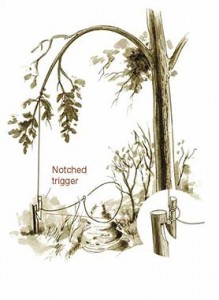
It sounds very simple, but it’s extremely effective in the right situations.
You can improve your chance of success by baiting the trap, thus drawing the animal towards it. As bait, you should use a food source that is not abundant in the area, yet the animal is familiar with.
Using bait when fishing isn’t an option if you want to catch one. A great bait for small mammals is peanut butter (from a MRE ration for example). When using bait, you can use “samples” to attract the animal’s attention, by scattering little bits around the trap.
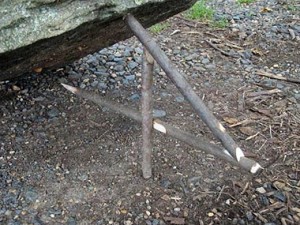
This trap uses a trigger in order to drop a heavy object over the animal.
The object must be heavy enough to kill the target upon impact.
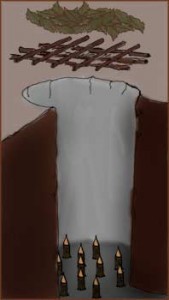
The only bad thing is that it requires a great amount of energy to build it, but it is very efficient.
You must first find a game trail and then you should dig the pit near it. When you consider the pit deep enough to hold the game inside it, you must place sharpened sticks at the bottom and then build a grill from sticks and branches to cover the hole.
Use leaves and grass to cover the grill and you’re ready to go.
Tips for Using Traps
These are some of the most used and easy to build traps and snares. A few things to consider when using them:
- You must position the traps where there is definitive proof that there are animals passing through, in order to be effective.
- Trap concealment is essential. You should avoid messing around with the vegetation and creating disturbance when installing the trap, as these things will alarm the animals. Don’t use freshly cut vegetation when constructing traps or snares.
- You must remove your scent from on and around the trap, or at least mask it with something. Removing the scent is next to impossible, especially in a survival scenario, but leaving it to begin with is another thing: using mud from a place with rotting vegetation works like a charm. You should use this mud to cover your hands when you’re handling the snare/trap and also to coat the trap when you’re setting it. Another trick is to use smoke for masking your scent on the trap parts.
Now that you have some ideas about the different types of traps, you’re a little better prepared to survive in the case of a SHTF scenario.
Please feel free to comment below if you have questions, suggestions, or something great to add!
This article has been written by Chris Black for Survivopedia.


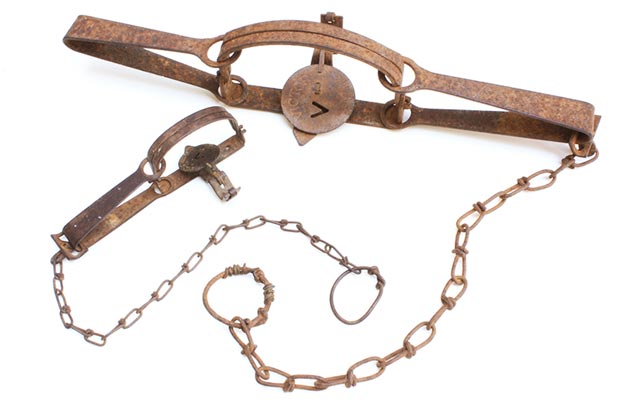
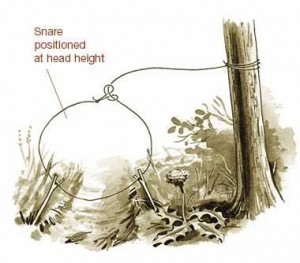




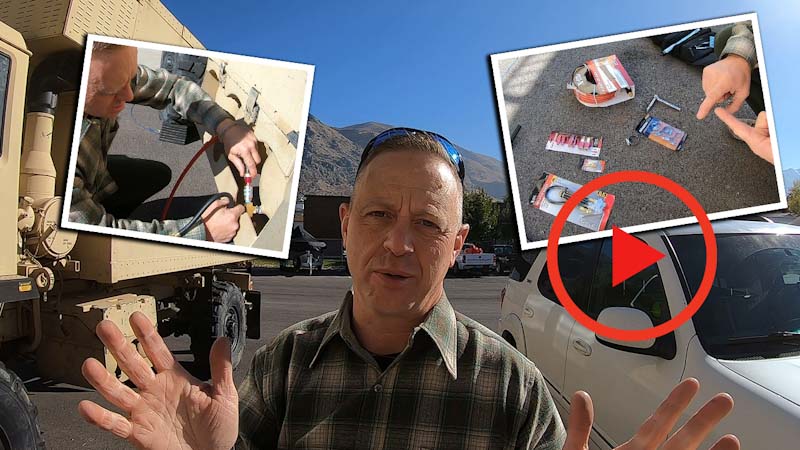


George | February 6, 2014
|
A good trap method I learned a couple of years ago is to take a rat trap drill a little hole in the middle of where the bale locks down. Put the trap about head high in a tree and put a screw through the hole to hold it there. Bait with peanut butter squirrels love it. The squirrels get trapped where other predators can’t get them. During warm days check traps often to prevent spoilage.
Jay B | February 7, 2014
|
What is the best type and size wire for small animal snares? Piano wire, cable, bailing wire? I figure rope, bootlaces, or leather could work, but the animal could also chew through it and would be more likely to hold unwanted scents.
Al | February 7, 2014
|
Could you give me a few design of snare,ie wire and type,locking method etc
Thank you
dave | February 7, 2014
|
to make it easy the snare shop has a survial pack the covers many types of animals and they come with a cd to show how to use if you are new to snaring. also do not forget about the body traps they come in a couple sizes but the most common are 110,220 and 330. 110 for small animals like rabbits 220 for raccoon,fox and the 330 for beaver,coyote. use caution with the 330 it will hurt if you get caught in it. i fur trap and you can use these traps to catch food or the skins to keep warm if you are in the cold. all of these traps you can do blind set meanning that you need no bait to catch your target animal. go to snareshop.com for info on snares remember you can get snares to catch large animals like deer if you think out of the box!
outback | February 7, 2014
|
Is there a .pdf download for this article?
Thanks
Jul Moore | February 10, 2014
|
My father in law told me they use to dig a pit, 1 1/2 feet deep, tapper a shoot into it and cover it to the entrance hole and spill some corn down the shoot to the bottom. When a wild turkey eats the corn down to the bottom he will not lift his head up to get out and stay in it. When you go back to check on it he will still be in there to catch. That was how they got turkey when they wanted one. Have seen this done also.
Terry Stark | May 12, 2014
|
This is an interesting idea but badly lacking in information. How big around is the 18″ deep hole? Taper as in a sloped chute into it? What does that mean? Cover it to the entrance hole? What is that? Why wouldn’t the turkey turn around and walk back out? Is there someone there who could do a better job of explaining this concept?
Rambuff | February 13, 2014
|
You NEED to render this, and all the other articles, in PDF format so we can keep them without having to waste paper.
The info is great; just wanna be able to refer to it post-TEOTWAWKI.
John Scheidecker | February 14, 2014
|
If you live where there is confinement housing for hogs, chickens, cattle, etc. there will be huge numbers of animals that will die without water or food. I think it might be a good idea to be prepared to butcher and preserve the meat. The owners of the animals will probably quite willing to see the animals not go to waste.
Pingback:7 Reasons to Take an Air Rifle for Survival Weapon | May 23, 2014
|
Pingback:7 Reasons to Take an Air Rifle for Survival Weapon | TheSurvivalPlaceBlog | May 24, 2014
|
John D. Schwerdtfeger | March 6, 2017
|
I absolutely believe in the power & need for air rifles in ones Bugout gear. So diw Lewis & Clarke who had one in their kit which was put to good use along the way putting grouse, dove, quail and the like on the menu with rabbits, squirrels & such. I have the Gamo “Big Cat” .177 1250 FPS muzzle velocity. The only complaint I have is the cheap bluing they put on they will get surface rust while your eating breakfast so you can either re-blue it or strip it down an paint it camo with Rustoleum was my choice.